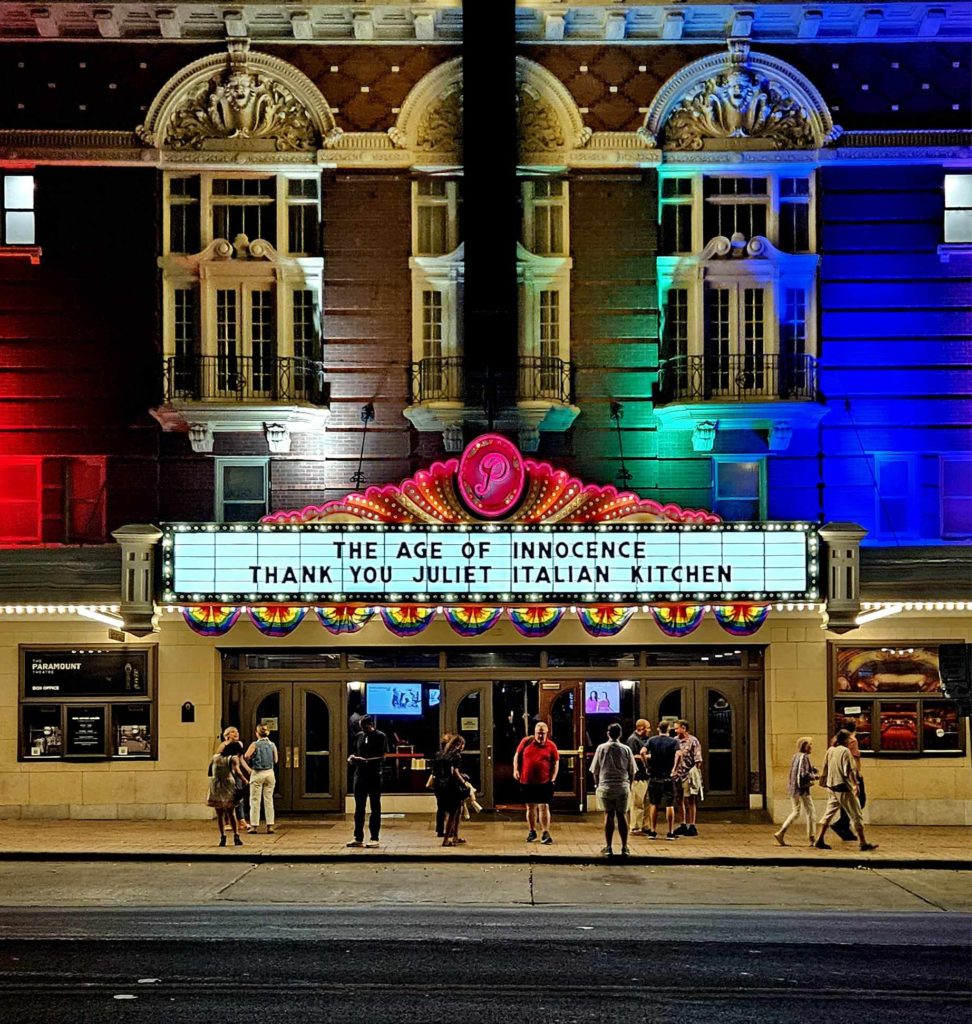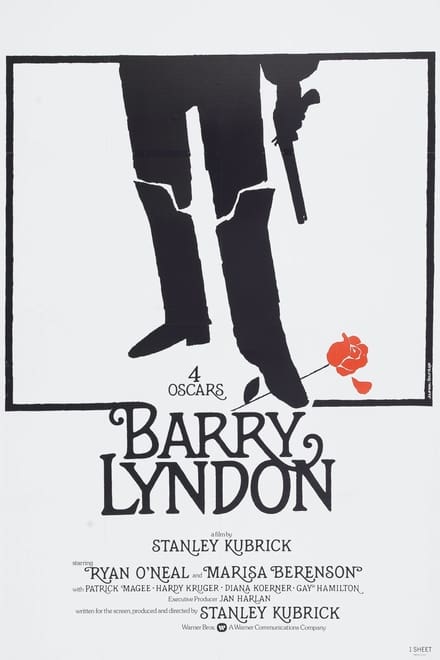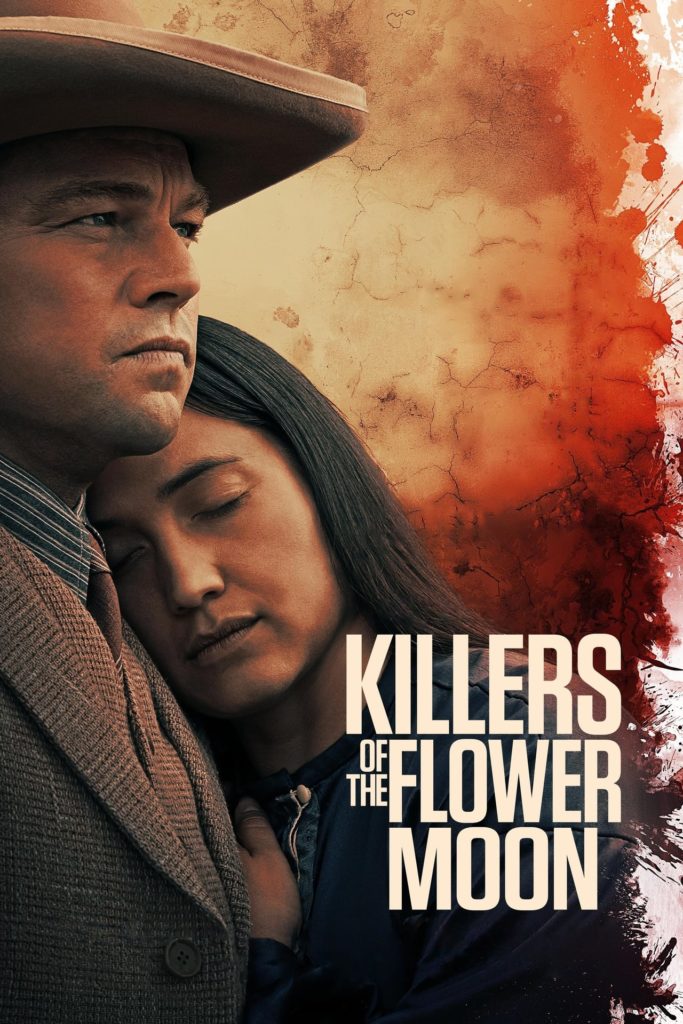Film Log #12 – 11.2023
Thursday, November 30th, 2023The Paramount Theatre’s Summer Film Series ended in September.
Here are three negative reviews and one positive.

The Age of Innocence
(screened 6.27.23)
Should’ve been more appropriately named, America’s Obsession with Opulence.
I don’t see the appeal of this subject matter.
As I sat in The Paramount Theatre watching Daniel Day-Lewis perform Scorsese’s vision of Edith Wharton’s literary depiction of 1870s New York City, I thought about another period piece DD-L appeared in– 1985’s A Room with a View and basically wished to be rewatching the latter instead of viewing the former for the first time.
I realize that Hollywood has always beaten trends to death and from the mid-80s to the mid-90s, there certainly was a rash of making this style of period pieces. And, perhaps like most people, when I’m experiencing movies from a certain era or about a certain topic, I just immediately compare what I’m seeing to what I already know.
And even though I don’t particularly love ARwaV (I’m not hustling out to rewatch or re-read it so I can provide an in-depth write up), I still remember enjoying it far more than The Age of Innocence/America’s Obsession with Opulence.
One piece of art celebrates the wealthy (and their inconveniences of their own design); the other mocks the attitudes and habits of the wealthy. For Scorsese to begin production on The Age of Innocence in 1991 and for it to be released in 1993– the timing seems telling. It’s as though when New York City, along with the rest of the country, was beginning to make some necessary noise about 1980s Trickle Down Economics and the growing disparity between the haves and the have nots, Scorsese’s response seems to be, “Hey, this is America and this is how it has always been.”
The story should be something that most people can relate to. A young couple gets involved and as the relationship progresses, one begins to develop feelings for someone outside the relationship. Plenty of people have been there.
The film then delves into the “agony” between these two lovers that, due to the social and cultural attitudes of the era, simply cannot be. I’m just not the demographic for this type of story. Considering the two films’ endings, I prefer George Emerson’s success in A Room with a View over the down-and-out mopiness of The Age of Innocence’s Newland Archer.
This is a specific film and you’d have to be very into costume design, set design, and emotional repression in order to enjoy this film.

Barry Lyndon
(screened 8.30.23)
For all the pomp and circumstance that comes with Stanley Kubrick’s Barry Lyndon (1975), I’m only grateful for having seen it so I can confidently know just what I wasn’t previously missing.
Yes, it’s incredibly well shot. “Every frame is a painting.”
But none of that matters if the story doesn’t engage.
The titular character is an unscrupulous man that isn’t interesting. The story does an excellent job at portraying nearly everyone involved as a static, one-dimensional character that never does anything truly transformative through the plot points.
Lyndon marries for money, lives inconsiderately, and doesn’t possess a single redeeming quality unless you fancy a man with fencing skills.
Character and story have to mean something. I’m the type of viewer that needs a reason to be invested. I need to be intrigued, invested in what is happening on screen.
This is admittedly sounding a bit high maintenance.
I think about films that have engaged me and I reflect on characters, on conflicts:
Almodovar’s Hable con Ella (2002) whose main character, Marco, supports a person (Benigno) who did a reprehensible and complicated thing because that oddly sympathetic villain once supported him during a difficult period.
Rafelson’s Five Easy Pieces (1970) and a man who can’t find fulfillment within academic or working class circles or intimate relationships, so he seems to continually feel lost; without a community. (There will be a write up on this film soon).
Bogdanovich’s The Last Picture Show (1971) and how “sexuality/adulthood” can sneak up on teens and how those who aggressively seek it are often most unprepared for “maturity” while also detailing cultural and generational shifts as well as highlighting the deep personal regret many people live with.
This is just to name a few. And what sticks in my craw most is when a filmmaker doesn’t first make me care about characters before telling me their story.
Why do I care? Why should I care?
As previously mentioned with Cool Hand Luke (1967), we are instantly shown Luke Jackson’s character and how that magnetic stubbornness would be his success and demise.
Conversely, Barry Lyndon paints the picture of a self-centered prick who seems to have been born a prick and dies a ne’er-do-well prick.
He’s definitely not a protagonist and there’s never a consistent antagonist, just a series of characters (who also aren’t worth rooting for) who go toe-to-toe with Barry Lyndon. I never really found the conflicts or personalities interesting.
To put it as concisely as I can– I saw a beautiful picture and didn’t care about whose portrait was being painted.

[This has nothing to do with The Paramount’s Summer Film Series– I recently saw this at Alamo Drafthouse in San Antonio– screened 11.10.23]
When a new film is released that I already have every intention of seeing, I avoid reading any reviews prior to screening. I prefer having a “clean slate” and not allow my first impressions to be coaxed one way or another.
This was the case for the much anticipated viewing of Killers of the Flower Moon.
Like most Americans born after 1970, Martin Scorsese’s work has certainly had an affect on me. After consulting his imdb page– I’ve seen 26 of his directed projects (there are 68 films, short films, music videos, and various TV projects listed), including 17 of his prominent 24 full-length features that were given wide releases.
Apologies for sounding like Dwight Schrute there.
It’s safe to say that I’m a Scorsese fan. Allow me to point out that I mostly defended his previous 3.5 hour release.
Before I earnestly begin listing the many ways I feel this film fails, may I recommend googling “Films about Native Americans/First Nations” and watch ANY two of those before spending 3.5 hours watching Killers of the Flower Moon.
Or hell, just read the Killers of the Flower Moon book instead.
After perusing a few of those lists, a few films that jumped out to me are:
Smoke Signals (1998)
Atanarjuat the Fast Runner (2001)
Drunktown’s Finest (2014)
Songs My Brothers Taught Me (2015)
Geronimo: An American Legend (1993)
I haven’t seen any of the above, but boy I wish I had instead of spending time with KotFM.
To return back to the matter of character– KotFM makes it difficult to find a three-dimensional character worth rooting for.
Obviously, provided the historical context we all know, The Osage characters are worth rooting for. But, for the most part, the film introduces The Osage as one-dimensional victims, and in most cases they die as victims very soon after their introduction.
The few times we are shown dimensionality, it’s fairly predictable– this character loves her mother, she’s a bit wild, she is loyal, but we all know the character we’ve been introduced to is about to be heartlessly murdered because that’s the entire premise of the film.
The three Osage characters given the most screen time aren’t particularly fully formed (more on that later).
Onto the white characters. The intention is to depict these people as evil, vile, and stupid. The film is successful in this regard. But villainy, stupidity, and evil alone don’t make for interesting characters worth investing in.
I’m reminded of films where evil foes had power over their victims and titles like Schindler’s List, The Shawshank Redemption, and Cool Hand Luke come to mind. Itzhak Stern (portrayed by Sir Ben Kingsley) is the very definition of a victim, yet that historical character’s dimensionality is wholly revealed in time.
In Shawshank and CHL, the inmates’ (victims) personalities are vibrantly displayed and the villainous warden/guards remain flat, one-dimensional.
In KotFM, every character is flat, motives are obvious, and the amount of screen time awarded to The Osage (the victims) vs. the screen time dedicated to depicting the witless lengths these white men (the antagonists) go to conduct heinous murders is terribly lopsided. So, what’s so damned interesting about seeing a clumsy collective of evil people casually discussing their villainy?
I haven’t seen Oppenheimer yet, but I imagine the crux of that film is that, as these brilliant people worked towards historic scientific breakthroughs, they had to consider that their project’s success may eventually lead to the deaths of hundreds of thousands.
That’s tension. Is the pursuit of scientific breakthroughs worth costing immeasurable human life and environmental destruction?
Do the ideas and discussions in Oppenheimer shape how we discuss current topics (AI, biological warfare, etc)?
KotFM, however, depicts eight evil simpletons dead set on getting the financial/oil rights belonging to The Osage people. Because killing many in hopes to misdirect their oilfunds is so abundantly abhorrent, there isn’t a tension to the narrative. The audience has nothing to consider other than will an Osage character die, how soon will they die, and will the evil people succeed in getting the money or will there be justice?
It plays out like a two-bit horror flick; not a poignant historical drama.
The flow of KotFM reminded me of Aronofsky’s Mother!. In Mother!, the audience is presented with an allegory about mankind, religion, and their relationship with our planet (“Mother Earth”). It slowly builds a torturous depiction of humanity and the audience mostly just wants it to end (or at least I did).
Other quick observations to note:
Scorsese has made hundreds of millions making violence and racism entertaining when done by east coast Italian-American or Irish-American characters. Now that he’s tackling a Central Standard Time storyline (flyover country), well, I guess violence and racism just isn’t as entertaining as it used to be.
Who is the protagonist? If you were to say it’s the main Osage character, Mollie Kyle (played by Lily Gladstone) who marries Leo DiCaprio’s character– due to the evil committed by her husband and in-laws, she spends most of the film bedridden and never truly has her moment of triumph.
About her being bedridden for much of the film, there are only a few scenes where the two main characters have meaningful conversations that go beyond the first act’s flirtations, and one of those precious scenes depicts the evil doer using modern medicine to push his disturbing plans.
I understand being truthful to the text and historical account, just odd in a post-covid world to hear the villain pushing modern medicine and for the audience to root for the heroine to reject modern medicine.
If you offer that the film’s protagonist is the FBI detective played by Jesse Plemons, it feels like his character isn’t even introduced until about the 2 hour 50 minute mark, giving his character only 35-40 mins to exist and he also doesn’t have a triumphant conclusion. Considering the history, it’s also kind of strange to position federal agents as advocates for Native Americans.
Unless you are determined to watch every Scorsese film, I recommend watching any of the “Films about Native Americans/First Nations” google search prior to watching this one.

Lost in Translation
(screened 7.27.23)
I’d like to end on a positive note.
The Paramount/State Theatre’s Summer Film Series screened Lost in Translation on 7.26.23 as a celebration for its 20th anniversary.
It was an excellent time warp.
There were a few disagreeable jokes made about Asian accents and such that wouldn’t pass today’s studios, but in the film’s defense, those poor-taste jokes were made by characters the audience is supposed to dislike. The “hero” and “heroine” of the film spend significant time immersing themselves in Japanese culture and nightlife.
That said, the film isn’t about celebrating Japanese culture, but about how someone recently out of college as well as someone who is more-or-less retired are both facing similar internal challenges.
Do I love my partner?
Am I in love with my partner?
What shared connections do I have in my life?
Am I happy with where my life is heading?
Has everything up until this point been one misstep after another?
What does happiness look like today and what do I believe it will look like a few weeks, a few months, a few years from now?
These existential and relatable dilemmas for these two very different characters are expertly exhibited; shown. If you ever took any sort of creative class, you’ve heard “Show. Don’t tell.”
Show us a situation that allows the audience to understand deeply personal quandaries; don’t just use expository dialogue to push the narrative.
Lost in Translation executes this perfectly.
It was refreshing to revisit.
I hope to review more refreshing experiences sooner than later.